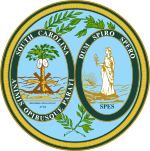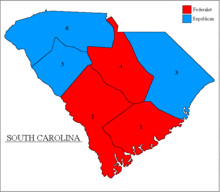1796 United States House of Representatives elections in South Carolina
Appearance
| Elections in South Carolina |
|---|
 |

| District | Incumbent | Party | First elected |
Result | Candidates |
|---|---|---|---|---|---|
| South Carolina 1 Also known as the Charleston district |
William L. Smith | Federalist | 1788 | Incumbent re-elected. | √ William L. Smith (Federalist) 84.8% Robert Simons (Democratic-Republican) 13.6% John Rutledge (Democratic-Republican) 1.6% |
| South Carolina 2 Also known as the Beaufort district |
Wade Hampton | Democratic-Republican | 1794 | Incumbent retired. New member elected. Federalist gain. |
√ John Rutledge, Jr. (Federalist) 87.3% Elnathan Haskell (Democratic-Republican) 16.7% |
| South Carolina 3 Also known as the Georgetown district |
Lemuel Benton | Democratic-Republican | 1793 | Incumbent re-elected. | √ Lemuel Benton (Democratic-Republican) 63.3% Tristam Thomas (Federalist) 24.4% Joseph Blyth (Federalist) 12.3% |
| South Carolina 4 Also known as the Camden district |
Richard Winn | Democratic-Republican | 1793 | Incumbent lost re-election. New member elected. Democratic-Republican hold. |
√ Thomas Sumter (Democratic-Republican) 50.7% Richard Winn (F[a]) 49.3% |
| South Carolina 5 Also known as the Ninety-Six district |
Robert Goodloe Harper | Federalist | 1794 | Incumbent re-elected. | √ Robert Goodloe Harper (Federalist) 67.6% William Butler (Democratic-Republican) 32.4% |
| South Carolina 6 Also known as the Washington district |
Samuel Earle | Democratic-Republican | 1794 | Incumbent retired. New member elected. Democratic-Republican hold. |
√ William Smith (Democratic-Republican) 37.0% Abraham Nott (Federalist) 32.5% William Will (Democratic-Republican) 25.4% Samuel Lowrie (Federalist) 2.6% Robert Anderson (Democratic-Republican) 2.5% |
See also
[edit]- United States House of Representatives elections, 1796 and 1797
- List of United States representatives from South Carolina
References
[edit]- ^ Although Winn had run as a Democratic-Republican in the previous election, the source used stated that he had run as a Federalist in this election, however, by the time he returned to Congress in 1801 he was a Democratic-Republican again
